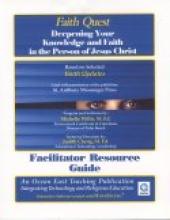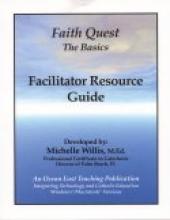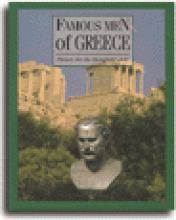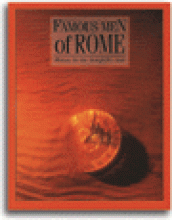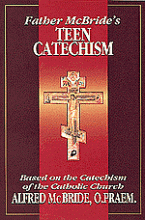No name
Faith Charts: The Bible at a Glance
Faith Quest: Deepening Your Knowledge and Faith in the Person of Jesus Christ
The course is divided into three modules. The first one aims to increase knowledge about the life and character of Jesus Christ, the second one focuses on the Lord's Prayer and getting to know God as Father, the third one focuses on Jesus's teachings in the Sermon on the Mount and how to live as Christians in the world. Each module has three or four lessons, for a total of 10 lessons. There is also a supplementary CD-ROM on the Ten Commandments.
The structure of the course is much like Faith Quest: The Basics. The curriculum is based on the CD-ROM which comes along with the Facilitator's Guide. You open the program and pick the lesson you are working on from the main menu. You can begin from the middle of a lesson if you left off without finishing. The first section of each lesson is on Vocabulary; the second section requires that you read the Youth Update, and the third section is a comprehension check to reinforce and review the information given in the Youth Update. For the first and third steps, there is a writing element as you write down the vocabulary or q&a on the reproducible sheets provided in the Guide.
When you have completed these steps, you can take the lesson Quiz. The quiz has true or false questions, a vocabulary bank, and multiple choice style questions. When a Module is completed, there is a paper crossword puzzle to review vocabulary, then a practice test on the computer, and then a Unit Test on paper.
The Facilitator's Guide contains instructions for how to install and use the software, a glossary of all the vocabulary words used in the curriculum, reproducible worksheets and quizzes, an answer key and "Youth Update" articles for each section of the course. The content of the course is based on these Youth Updates, which are nicely done several-color reprints of articles from St Anthony Messenger Press and have an Imprimatur. If you are using the program with more than one student, you need to get additional copies of these articles, and the address for ordering is in the Guide.
Both the paper material and the computer material are very nicely laid out, attractive without being flashy or distracting. The Youth Updates tie contemporary youth concerns and topics in with truths of our faith. The structure of the computer and paper parts of the course is designed to let the student work at his own pace and to provide plenty of review and practice. Since every lesson and module have an identical structure, once the student understands the method there are no surprises. He is free to work on mastering the actual content.
There is a supplementary Ten Commandments CD-ROM which covers the commandments and the vocabulary associated with them.
A complete religious education program needs to include some time for students to interact with real people, in discussion and involvement in the community and the church. This program in itself doesn't provide that. What it does provide is something that is often lacking in religious education nowadays: mastery of essential doctrine. This resource would work well as one component of a religious education class that had the technology: computer stations with WIN95 or higher and headphones. It takes most of the guesswork and dullness out of ensuring that every student knows basic terminology and concepts. Each student can work at his own pace, and each student must master the vocabulary and concepts before proceeding.
Faith Quest: The Basics
The Facilitator Guide includes an overview of the materials, Lesson Worksheets, Quizzes, Crossword Puzzles, Unit Practice Test, Unit Test, and Answer Keys.
When you turn on the program, you hear pleasant contemporary music as the title and other basic information comes on the screen. In fact, music is interspersed throughout the program. The instructions are easy to follow. Other than a computer, the only other requirement is that the student should be able to read. Because of the index menu, the student is able to leave off in the middle of a lesson and return to it later.
Lesson 1, Step 1 is vocabulary. A lovely picture is in the background, reflecting the beauty of God's creation, as the first vocabulary comes on the screen with a short, simple, and accurate definition. Throughout the program, there are various sound effects to catch the student's attention with the changes of the information, while the picture may remain the same. In step one, the sound effects accompany each new word. The picture only changes when moving from one step to the next. A pleasant woman's voice reads the word and the definition. At this point, the student should write down the definition he has just heard and read on his worksheet. This incorporates three senses. The student is listening, reading, and writing. When the student is ready, he clicks on the move ahead button.
In step two, a new background picture appears on the screen as the question on the worksheet with the answer come on the screen. Again, sound effects accompany the change of text, while keeping the picture the same. After the word and definition are given, the text changes (after the student clicks on the move ahead button) to a scriptural reference and/or a reference to the CCC. Because of the length of the text, there is no voice to accompany the reading of the text in this step.
After completing these steps, the screen changes again to the "Challenge" portion. In Lesson one, the student is asked to recite the Apostles Creed and explains the significance of knowing the Apostles Creed in defending our faith to others. For those who don't know it, the next section displays the Apostles creed on the screen along with music. In Lesson one, it closes with a Question and Answer. Not all lessons close with a final question.
At the end of the four lessons, there is a Unit 1 Practice Test on the computer, covering all four lessons. The first 20 are multiple choice questions. Questions 21-30 are true/false. Questions 31-40 are statements with two words highlighted as choices for answers. The student must click on the correct choice. A cymbal clashes with the correct answer. The final Unit test is only in the Facilitator's Guide.
In the Facilitator's Guide, after the overview of materials, the following sections are included.
Lesson 1 is "You Are a Special Creation of God." Step one is "Building Your Faith Vocabulary": Apostles, Creature, Creed, Crucified, etc. There are sixteen vocabulary words in lesson 1. In Step Two, the student answers fundamental questions such as "Who created the world?" There are references to the CCC or scripture throughout all the questions. The next section of Lesson 1 is a crossword puzzle on paper, reviewing the vocabulary in Step One. The next section is a Quiz that includes matching and fill in the blank.
The next three lessons cover: The Nature and Mystery of God; Creation, Angels, and Original Sin; and Understanding the Meaning and Nature of Sin (all with a similar format to the first lesson). Although the format may not seem like much material, the student should have a through grounding in these topics when he is finished.
I think this program is ideally suited for the student who is used to a lot of media stimuli. It concentrates on "sound bite" messages with a grounding in the basics with scriptural references and the Catechism of the Catholic Church.
Because the program incorporates all the senses and the student can go at his or her own pace and go back and review at any time, I can also see this program as ideal for the special needs student who has difficulty reading or processing information or retaining large chunks of information, Since the student sees the words on the screen as well as hears them spoken, and then writes the definition down, retaining information should be easier. For a student who has English as a second language, this would also be a good program provided the student has at least minimal reading skills. A mentor could also read the longer sections and explain them as needed. This program would also be ideally suited to the student who needs foundational knowledge or who needs a basic review.
The program is visually appealing as well as well presented and gives a through grounding in the faith. Another advantage to the program is that the student is able to work at his or her own pace. Because of the crossword puzzles, quizzes, and tests, the teacher can easily determine whether or not the student is grasping the material.
Since the program has the student working primarily independently, the teacher should set aside some additional time to discuss and apply what the student has learned to real life situations.
Imprimatur
Famous Figures of Ancient Times
More info available at the publisher's website: www.figuresinmotion.com
Famous Men of Greece
The introduction gives a brief description of the pantheon of mythical gods and goddesses of Greece. The book explains that this is how the Greek citizen of ancient times would have started with the historical record -- that though we call these stories "myths" now, they tell us something about how the people thought in those days. From there, the first nine chapters cover figures of legend -- where possible truth is mixed with make-believe. These stories are also important to Greek history, because they show what the Greeks valued in their heroes and the stories they learned and told to each other. Starting with Chapter X on Lycurgus the Spartan who lived in the 9th century B.C., we reach the actual historical record. The book advises the student to learn to discern between history, legend and myth in his reading and to ask himself "What things in this story could really have happened?"
My children, who use this book as a history spine in 4th grade, have all loved these tales of Greek heroes and statesmen. In addition to showing the continuum between legend and historical records, these books provide what to me is of first importance: lessons in evaluating people and events through an ethical, Christian perspective. History learned by stories is more easily remembered for children grades 3 to 7 than lists of facts and details to memorize for tests. Also, this is the way the ancients themselves learned and wrote history; showing the importance of their values through the lives of their good and their bad leaders.
Copyrights 1904/1989
Famous Men of Rome
Our second year of homeschooling, we discovered Greenleaf's Famous Men series (through enrolling in the Kolbe Academy Home Study program). What a difference! It was our first exposure to literature-based history study, and the idea of studying time periods through "real books" was a formative one in our homeschool.
Famous Men of Rome was written very early in the 20th century and revised by Rob Shearer of Greenleaf Press. Its operating principle is that history is not primarily about dates and facts; it is about the lives and actions of people. Consequently, it is divided into a series of "Lives", chronologically arranged, simply and memorably telling of the lives and choices of leaders and great men in the history of Rome.
There are thirty chapters in the book, starting with Rome's origin according to legend: the story of Romulus and Remus and their upbringing by a wolf, which became the symbol of Rome's self-identity in its later years. The rest of the book focuses on one historical "famous man" per chapter, with approximate dates of their lives. The stories are told as tales of virtue and vice and how individual actions and characters can affect history, not as dry collections of historical facts to memorize. My highschooler still remembers, from fifth grade, Horatio at the bridge and Cicero ending every speech to the Senate with "And Carthage must be destroyed!" The chronological range of the book is from 753 BC, the estimated founding of Rome, to 476 AD, the end of the Western Empire as Italy became a barbarian kingdom under the rein of Odoacer.
Though the stories in Famous Men of Rome are almost always very interesting, the writing style is quite simple. This might be a drawback to some families who prefer a more literary, complex style. But it does mean that an average 5th grader can read with comprehension and focus on content and meaning. Another possible criticism might be that taken by themselves, the Lives give a sort of scattershot perspective of the course of history - like a slideshow compared to a video. However, in my view the biographical presentation gives history more meaning and interest, and also allows us to compare and contrast the characters of these great men and see how their actions influenced their times.
The book is probably targeted to a third to seventh grade level. It makes an excellent read aloud, but can also be read independently. Kolbe Academy uses it for the history spine in fourth grade. An older student could read the book as an informative supplement to primary source reading in junior high to high school.
Faraway Island
So, it just slightly based on the meager accounts of a tale that may have really happened... but still, it makes for a wonderful picture book! Perseverance, kindness, mystery... and true love bringing life to a lonely soul, all in the backdrop of the great navigations involving the Queen of Portugal herself: how can a reader resist it?
Suchi adds: The tale is based on the semi-legendary story of Fernando Lopez, who was a sort of Johnny Appleseed to the island of St. Helena. When he arrived, it was a barren spot in the Atlantic, but over the years, his work transformed it into a lush, beautiful island. Portuguese sailors would stop off there, take what they needed, and leave him grains and plants – even fruit trees – that he would plant and care for.
Father McBride's Teen Catechism
Teen Catechism is a nice entry point into the Catechism of the Catholic Church. In spite of its name, Teen Catechism could be used by an adult convert or any person who wants a solid introduction to or review of our Catholic faith. It follows the topic sequence of the Catechism, covering the Creed, the Sacraments, Morality, and Prayer in its 36 chapters.
Each chapter begins with a passage quoted from another source which is selected as a lead-in to the chapter's topic. The purpose is to raise questions in the reader's mind, or make him aware that there is a question involved. This is followed by a "Some Say" section which is a wrong or incomplete version of the answer. Then there is a "The Catechism Teaches" section which contains quotes from the Catechism on that topic, and "We Catholics Believe" which translates the CCC quotes into everyday language. The "Reflection" is a quote from Scripture or a saint's writings which allows one to meditate further on the topic. Each chapter concludes with "In my Life" a series of open-ended questions which lead the reader to ponder how to apply the stated truths of the chapter to his life. Finally, there is a Prayer and a glossary of theological terms used in the chapter.
The layout is very clear and easy to follow. A variety of fonts are used to distinguish the different parts of the chapter from each other. Brief Scripture verses introduce and conclude the meditations. There is at least one black and white illustration per chapter, either a photograph or a sketch related to the topic. The strategy within the chapters is somewhat similar to St Thomas Aquinas's layout in the Summa Theologicae — a question, some objections, then a reply to the objections. This approach is well suited to the world we live in today, where we often hear a multiplicity of different opinions on a topic, and it is difficult to sort out which is closest to the traditional teachings of the Church.
The book could easily be used in a discussion group, or even as topics for personal devotions. It would be easy to plan "extensions" or further study on a given topic, either by looking into what the Catholic Catechism says in full, or by doing further research on the saints and other people mentioned within the book.
So much of the time, the word "teen" is associated with trendy, lightweight resources, but this book is quite the opposite. It is a solid and thoughtful introduction to the basics of our Catholic faith. One caution for younger readers: in the sections on the 6th and 9th Commandments, the opening stories are of St Maria Goretti, and the story of Susannah and the wicked judges. While the stories are not unnecessarily graphic, they do cover the topic of rape and violence, and may need to be discussed by parents with their younger teenagers.


